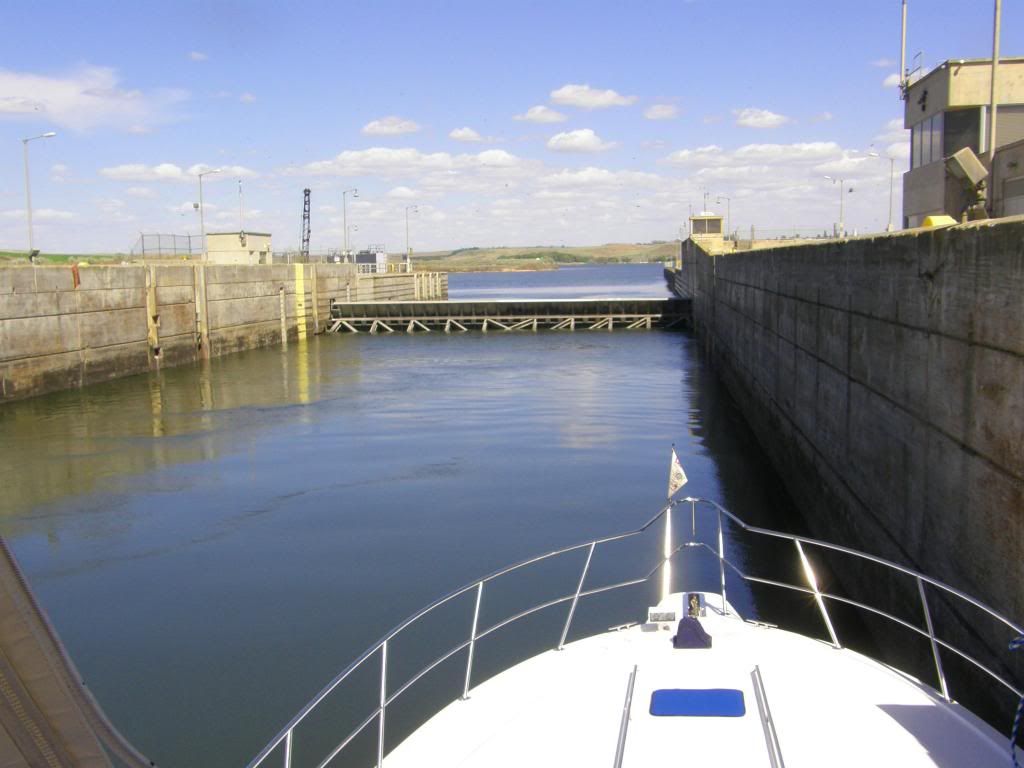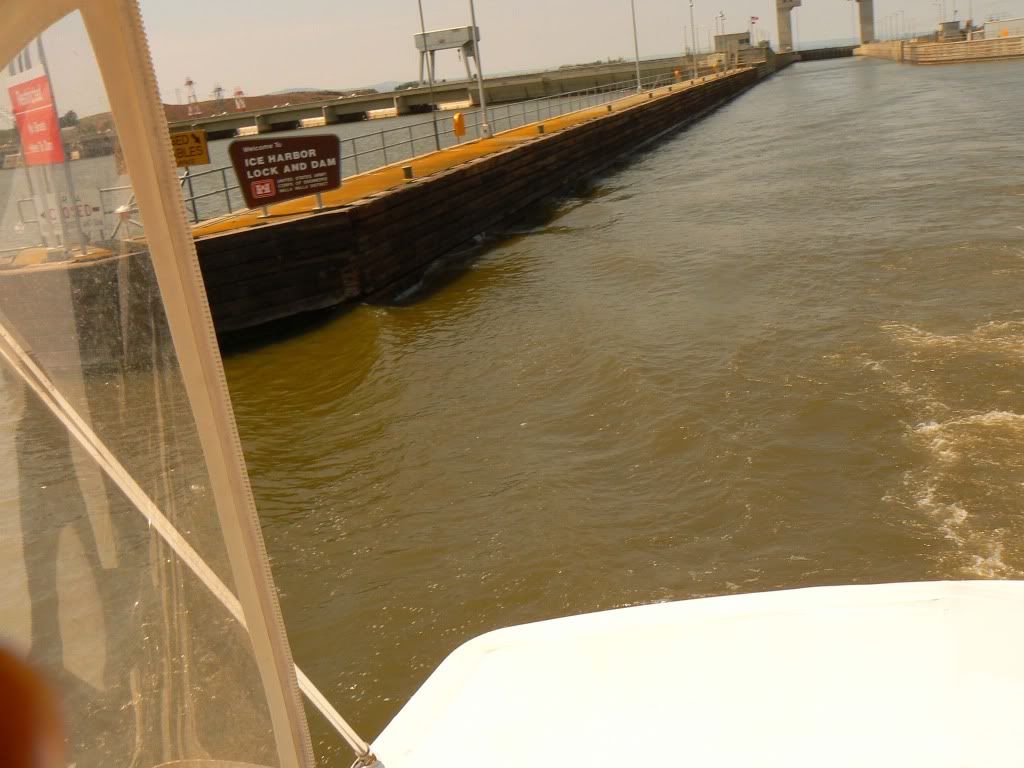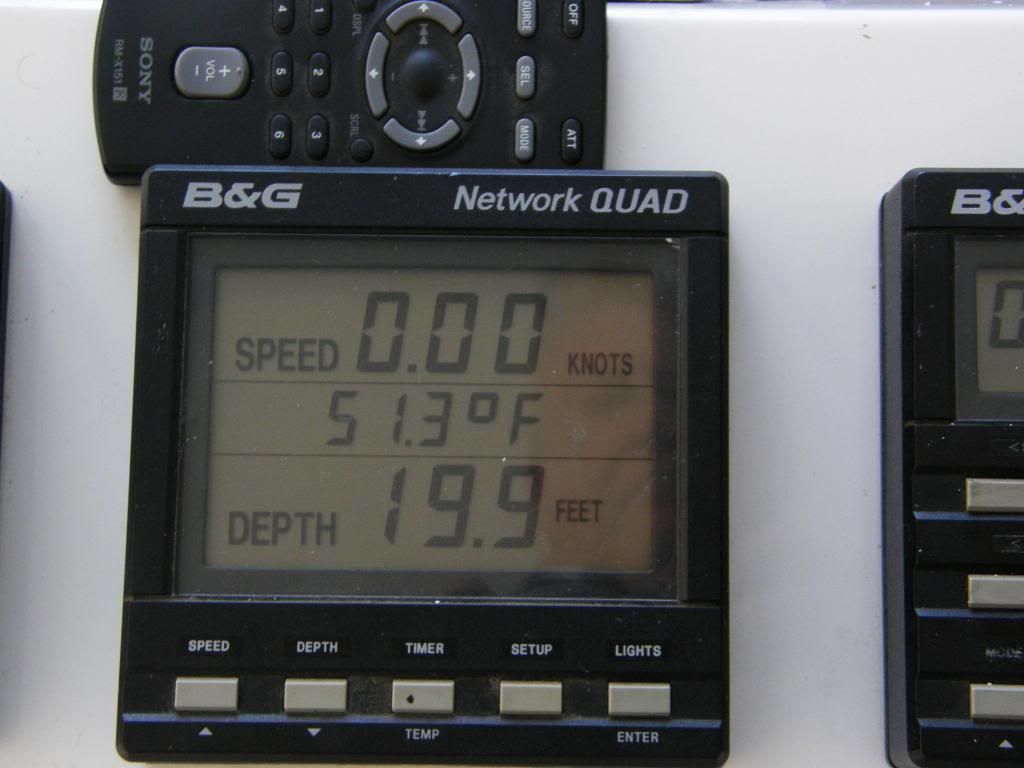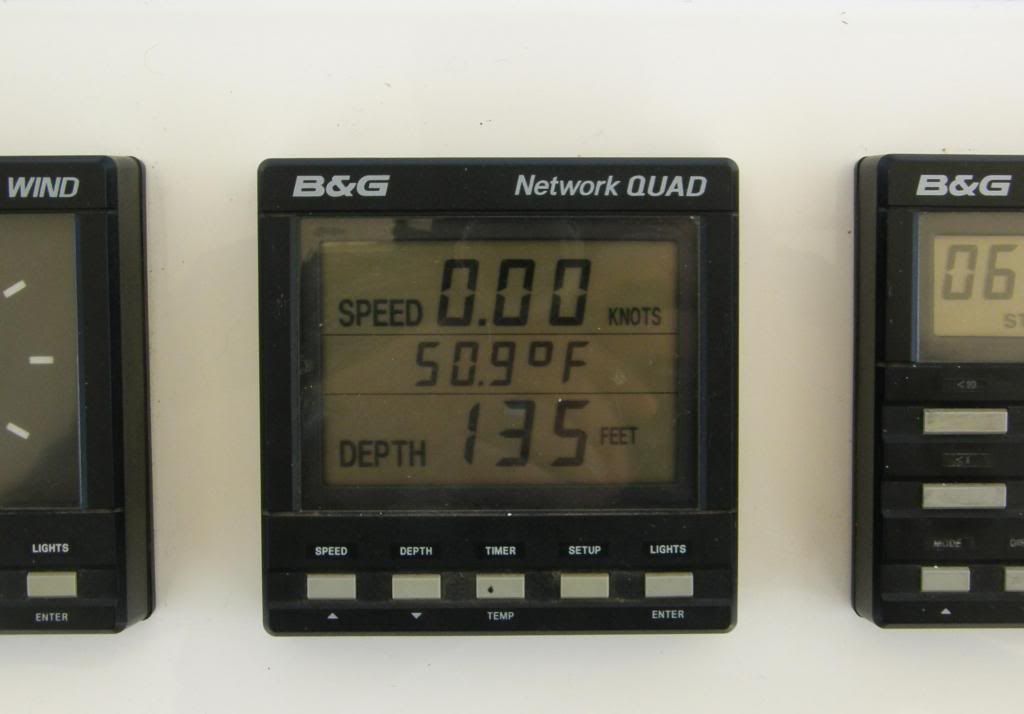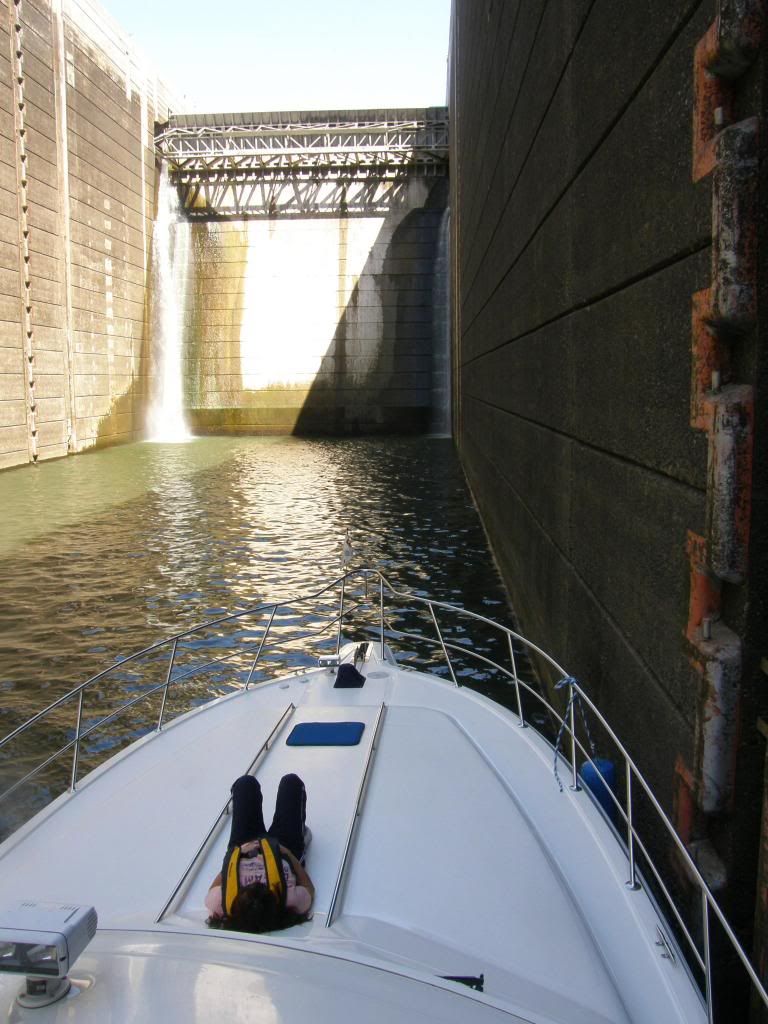Gofirstclass
Well-Known Member
On another forum a question was posed about the protocol for passing through the locks on the Columbia River and Snake River. Rather than take that thread any further off course I decided to start a separate thread to cover that and answer any questions about the locks. So I figured I'd post this same thread on here. I hadn’t planned this to be so long but I’ve tried to answer as many questions as I could.
The locks are operated and maintained by the US Army Corps of Engineers. USACE Walla Walla District controls the locks on the upper Columbia River and the Snake River. USACE Portland District takes care of the locks on the lower Columbia River.
While the locks are all pretty much the same in the way they operate, there are differences between the locks, albeit minor ones. Each lock has a Lock Operator or Lock Master who controls the every facet of the operation of his lock. He determines when a boat can enter, which boat comes in first, where each boat can tie up to the floating bollards, etc.
Between Sept 15 and May 15, government and commercial vessels have priority over recreational vessels. Also, during those times boats can enter the lock at just about any time (daylight hours) and will be locked up or down. The remainder of the year the locks have set times when they will operate. Those times are 9:00 a.m., noon, 3:00 p.m., 6:00 p.m. and 9:00 p.m. for upstream lockages. Downstream lockages are 30 minutes later.
The locks also differ in how boaters are treated. In the locks on the downstream end of the Columbia where they have a lot more recreational traffic and likely a lot more skippers who don’t know what they’re doing, the lockmasters assign your boat to a specific bollard. There are eight bollards in each of the locks and they’ll tell you which one to tie up to. On our locks up on this end of the Columbia and on the Snake they don’t do that and allow you to pick your own bollard. It also helps that, after going through the locks many times we’ve gotten to know the lockmasters by name and they know that I’m one who knows how to lock through. I think they also can determine from the way a person handles his VHF talk how knowledgeable a boater he is, and their attitude reflects that.
As you approach the lock to go through, boaters can call the lockmaster on VHF14 and request lockage. We usually call them about 30 minutes out so they know we’re coming. That way if the lock needs to be “turned around” (i.e., the water level in the lock is at the top and it needs to be at the bottom for us to go through) it give him time to accomplish that.
We also call when we arrive at the lock. The lockmaster will give you a green light to enter when everything is ready. That’s your signal that you’re clear to proceed into the lock. Another advantage of calling ahead is that you will generally have a green light when you arrive so you don’t have to wait.
The locks on the Columbia and Snake rivers are among the largest in the country, if not the world, in terms of how high they raise/lower a boat. There are dams that are taller, but they don’t have navigation locks. Each of the locks is 86’ wide and around 675’ long. The length varies a bit from lock to lock but the width is a constant so they can handle the barges. The lift also varies from lock to lock, with Ice Harbor lock being about the highest with an average lift of 105’. I’ve been through Ice Harbor lock during the spring runoff when the upstream water level was high and the lift was 118’.
When boaters pass through many locks in other areas of the country they either toss a line up to lock workers on the wall of the lock, or the lock workers toss down a line to the boat. In either case, they use the line to keep the boat in position and adjust the length of the line as the boat rises or falls.
That’s not a workable system when you have a lift of 100’+ so these locks have large tin cans called bollards. The bollards float and are free to move up and down as the water level in the lock is raised or lowered. The bollard has steel wheels on opposite sides that roll up and down in tracks built into the walls. Here’s a picture of a typical bollard, this one at Ice Harbor lock.
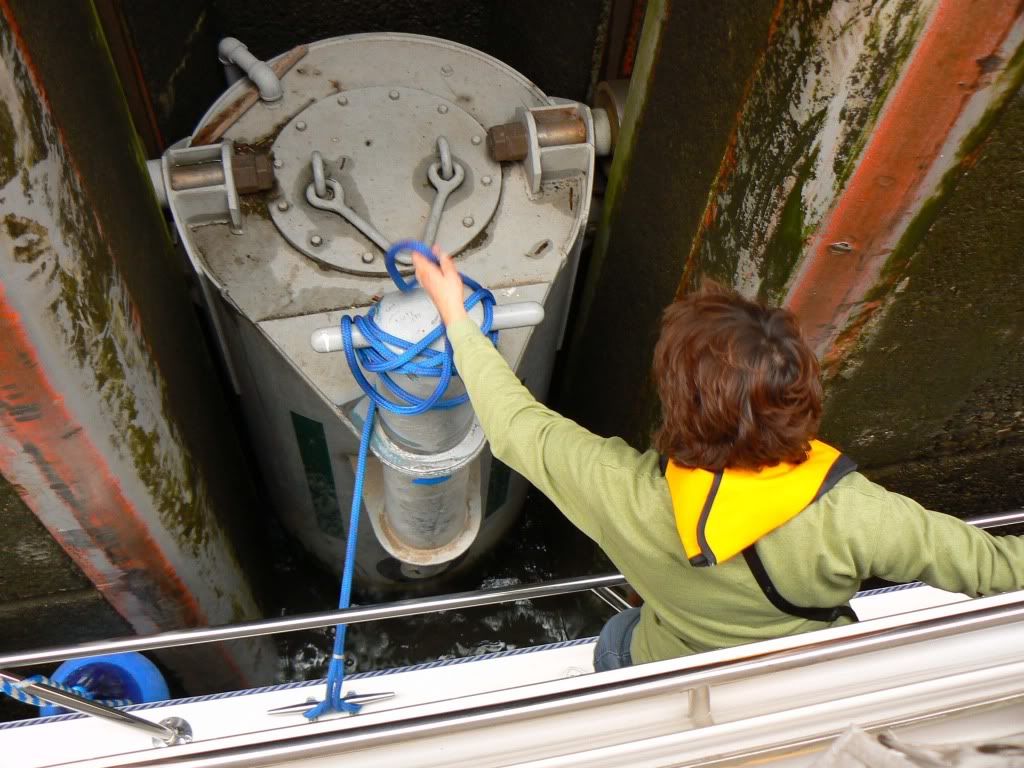
Usually the bollard just floats there, but if there’s any wave action inside the lock, here’s what can happen
[video=youtube;7n6rp7KlG7s]https://www.youtube.com/watch?v=7n6rp7KlG7s[/video]
Normally the lockmaster will keep the guillotine door open until everyone is secure. There have been times when they’ve shut it at our request prior to us tying up at a bollard. We’ve done that twice, and both times when the wind was coming through the opening beneath the door so hard it was causing a large wave action and making tying up almost impossible.
In both of those times we just held position in the middle of the lock until the door got down and the winds died. That’s what was going on in the video I posted above.
When a boat comes up to the bollard it is secured to the large cleat on the top. Boaters have the option of securing to the cleat using a bow line and stern line, or as we do it, with a line from our mid-ship cleat to the cleat on the bollard.
As a boater approaches Ice Harbor lock from the downstream side, here’s what he sees. These pictures were taken during the spring runoff so the water is turbulent and contains a lot of silt.
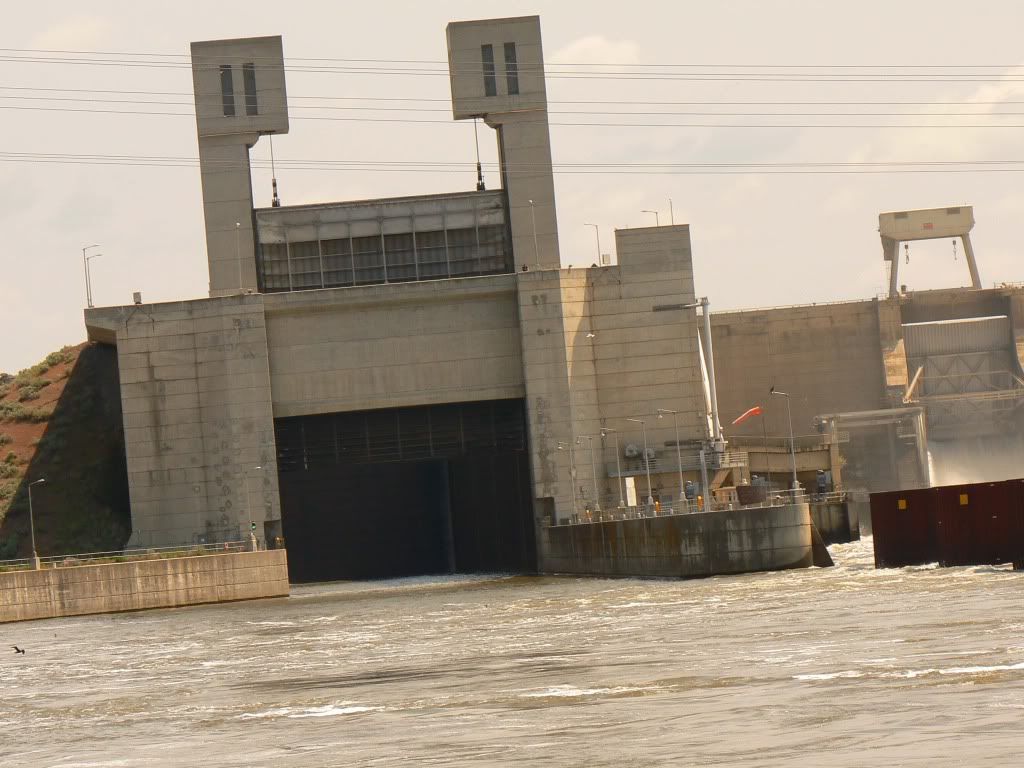
The two tall towers hold the cables that lift the guillotine gate at the downstream end of the lock. When they have tugs coming through they raise the gate all the way up, creating about a 50’ tall opening. The opening to the lock is the black hole right in the middle of this shot.
The day these pics were taken there was about an 8-9 kt current running down the river. Here’s a shot of a red nun buoy that is almost completely under the water because of the current. This makes navigation a bit tricky at times.
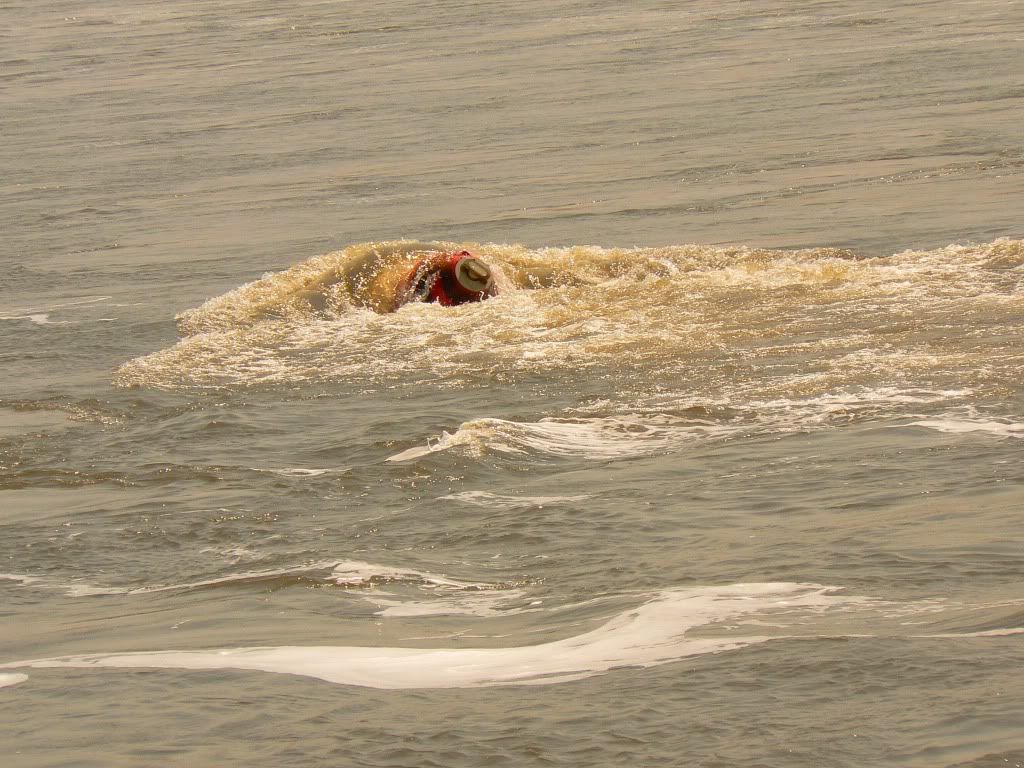
Here’s what the lock looks like as you enter. I’ve gone through this lock many times and it’s still a bit overwhelming.
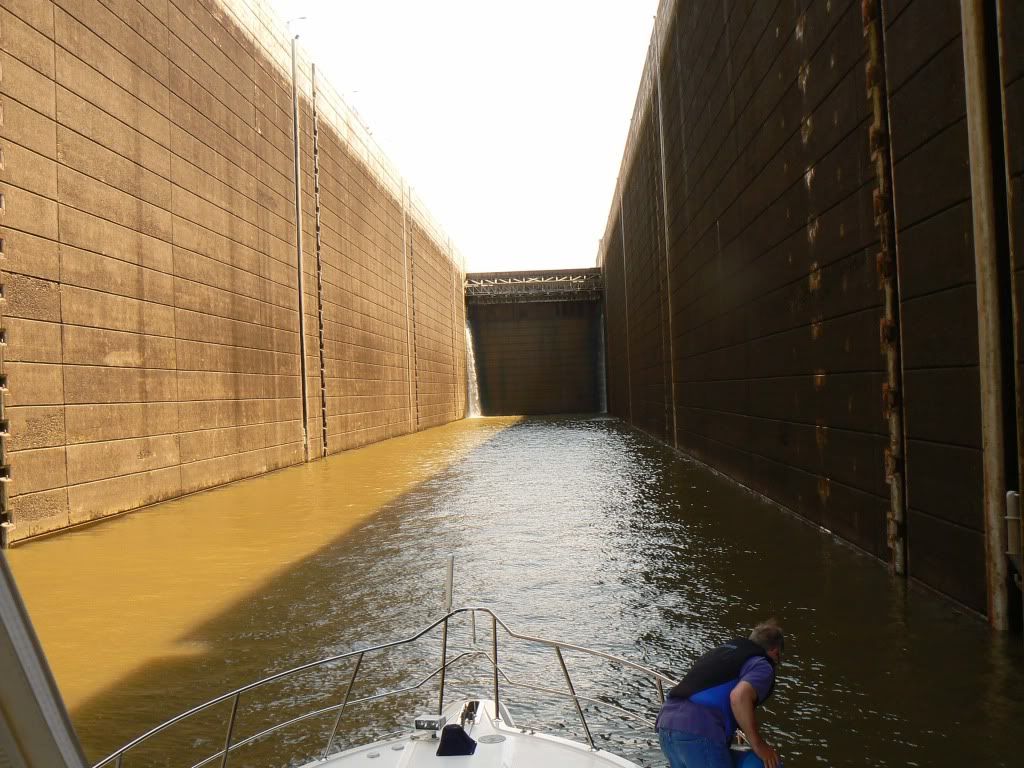
When the wind is blowing it swirls around inside the lock and tosses even large boats around like they were toys. This happened to me a year or so ago and we ended up getting spun around in the lock. The port stern of my boat struck against the wall and caused about $1,800 damage.
Here’s a shot looking back toward the guillotine gate as it’s being lowered.
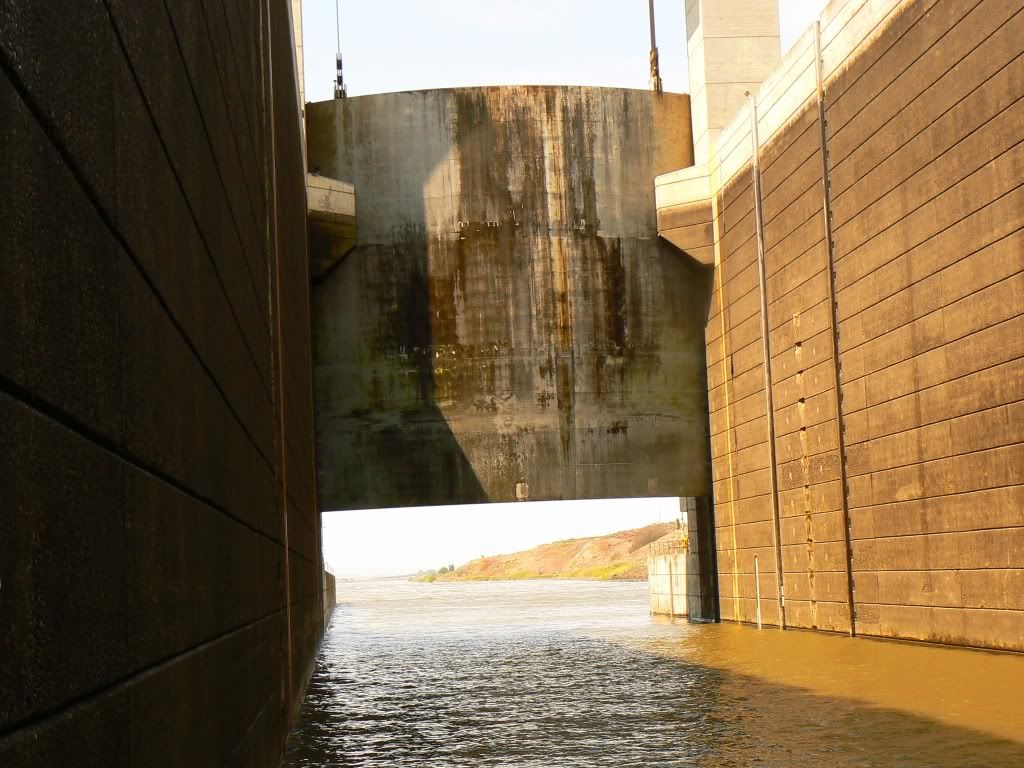
When the boater has his vessel secured to the bollard it’s customary to call the lockmaster on VHF14 to let him know you’re secure. PFD’s are required inside the lock for any passenger on a vessel who is outside an enclosed cabin. Once you’ve notified the lockmaster that you’re secure he turns some switches that open valves beneath the floor of the lock. There are no pumps involved in raising or lowering the water level, it’s all done by gravity.
If you’re going upstream, the lockmaster opens the valves and the water rises to seek the same level as the river above the lock. The water flows into the lock from the upstream side and it’s just like filing a bath tub.
This water coming in can create turbulence in the lock. It also pushes against the bow or stern of boats that are tied to the bollards. If you’re not securely tied and you’re near the upstream end of the lock, the water is pushing on your stern. That tends to push your bow toward the wall of the lock, so lots of fenders between your boat and the lock are needed to prevent damage. If you’re near the downstream end of the lock the water is pushing against the bow and doesn’t have the same effect, though it does try to push the boat back and, because the boat is pivoting around the bollard it can push the stern against the wall. The force isn’t as great but large fenders are still needed.
Here’s a shot of the turbulence in the lock as the water is being let in.
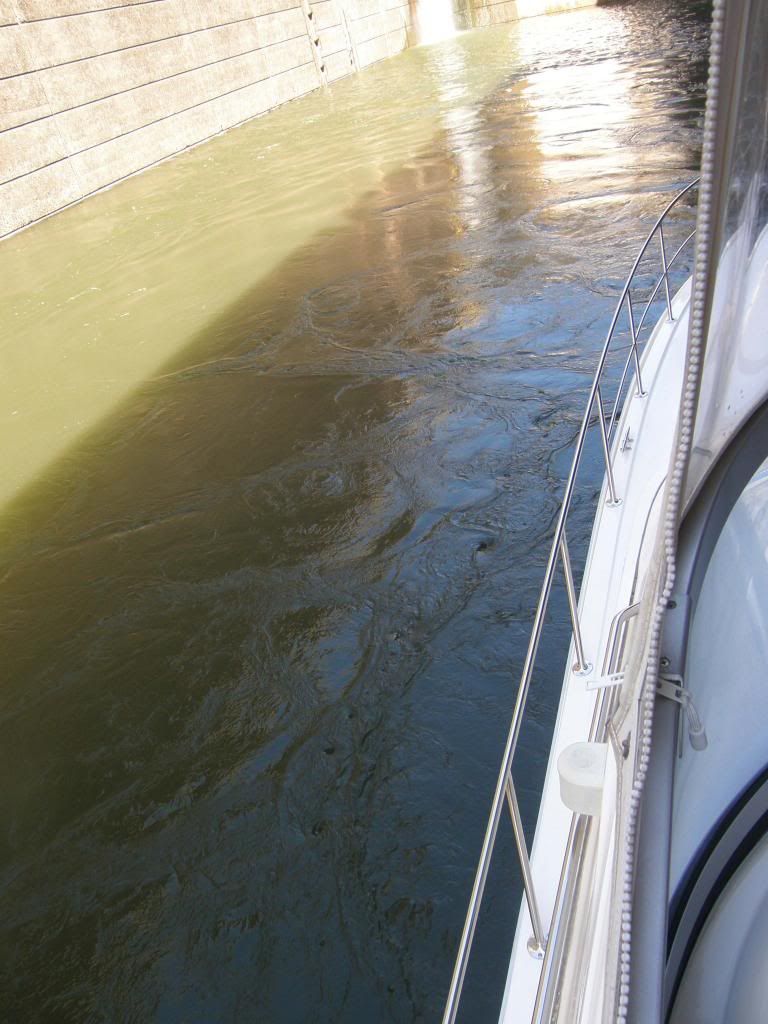
continued.....
The locks are operated and maintained by the US Army Corps of Engineers. USACE Walla Walla District controls the locks on the upper Columbia River and the Snake River. USACE Portland District takes care of the locks on the lower Columbia River.
While the locks are all pretty much the same in the way they operate, there are differences between the locks, albeit minor ones. Each lock has a Lock Operator or Lock Master who controls the every facet of the operation of his lock. He determines when a boat can enter, which boat comes in first, where each boat can tie up to the floating bollards, etc.
Between Sept 15 and May 15, government and commercial vessels have priority over recreational vessels. Also, during those times boats can enter the lock at just about any time (daylight hours) and will be locked up or down. The remainder of the year the locks have set times when they will operate. Those times are 9:00 a.m., noon, 3:00 p.m., 6:00 p.m. and 9:00 p.m. for upstream lockages. Downstream lockages are 30 minutes later.
The locks also differ in how boaters are treated. In the locks on the downstream end of the Columbia where they have a lot more recreational traffic and likely a lot more skippers who don’t know what they’re doing, the lockmasters assign your boat to a specific bollard. There are eight bollards in each of the locks and they’ll tell you which one to tie up to. On our locks up on this end of the Columbia and on the Snake they don’t do that and allow you to pick your own bollard. It also helps that, after going through the locks many times we’ve gotten to know the lockmasters by name and they know that I’m one who knows how to lock through. I think they also can determine from the way a person handles his VHF talk how knowledgeable a boater he is, and their attitude reflects that.
As you approach the lock to go through, boaters can call the lockmaster on VHF14 and request lockage. We usually call them about 30 minutes out so they know we’re coming. That way if the lock needs to be “turned around” (i.e., the water level in the lock is at the top and it needs to be at the bottom for us to go through) it give him time to accomplish that.
We also call when we arrive at the lock. The lockmaster will give you a green light to enter when everything is ready. That’s your signal that you’re clear to proceed into the lock. Another advantage of calling ahead is that you will generally have a green light when you arrive so you don’t have to wait.
The locks on the Columbia and Snake rivers are among the largest in the country, if not the world, in terms of how high they raise/lower a boat. There are dams that are taller, but they don’t have navigation locks. Each of the locks is 86’ wide and around 675’ long. The length varies a bit from lock to lock but the width is a constant so they can handle the barges. The lift also varies from lock to lock, with Ice Harbor lock being about the highest with an average lift of 105’. I’ve been through Ice Harbor lock during the spring runoff when the upstream water level was high and the lift was 118’.
When boaters pass through many locks in other areas of the country they either toss a line up to lock workers on the wall of the lock, or the lock workers toss down a line to the boat. In either case, they use the line to keep the boat in position and adjust the length of the line as the boat rises or falls.
That’s not a workable system when you have a lift of 100’+ so these locks have large tin cans called bollards. The bollards float and are free to move up and down as the water level in the lock is raised or lowered. The bollard has steel wheels on opposite sides that roll up and down in tracks built into the walls. Here’s a picture of a typical bollard, this one at Ice Harbor lock.

Usually the bollard just floats there, but if there’s any wave action inside the lock, here’s what can happen
[video=youtube;7n6rp7KlG7s]https://www.youtube.com/watch?v=7n6rp7KlG7s[/video]
Normally the lockmaster will keep the guillotine door open until everyone is secure. There have been times when they’ve shut it at our request prior to us tying up at a bollard. We’ve done that twice, and both times when the wind was coming through the opening beneath the door so hard it was causing a large wave action and making tying up almost impossible.
In both of those times we just held position in the middle of the lock until the door got down and the winds died. That’s what was going on in the video I posted above.
When a boat comes up to the bollard it is secured to the large cleat on the top. Boaters have the option of securing to the cleat using a bow line and stern line, or as we do it, with a line from our mid-ship cleat to the cleat on the bollard.
As a boater approaches Ice Harbor lock from the downstream side, here’s what he sees. These pictures were taken during the spring runoff so the water is turbulent and contains a lot of silt.

The two tall towers hold the cables that lift the guillotine gate at the downstream end of the lock. When they have tugs coming through they raise the gate all the way up, creating about a 50’ tall opening. The opening to the lock is the black hole right in the middle of this shot.
The day these pics were taken there was about an 8-9 kt current running down the river. Here’s a shot of a red nun buoy that is almost completely under the water because of the current. This makes navigation a bit tricky at times.

Here’s what the lock looks like as you enter. I’ve gone through this lock many times and it’s still a bit overwhelming.

When the wind is blowing it swirls around inside the lock and tosses even large boats around like they were toys. This happened to me a year or so ago and we ended up getting spun around in the lock. The port stern of my boat struck against the wall and caused about $1,800 damage.
Here’s a shot looking back toward the guillotine gate as it’s being lowered.

When the boater has his vessel secured to the bollard it’s customary to call the lockmaster on VHF14 to let him know you’re secure. PFD’s are required inside the lock for any passenger on a vessel who is outside an enclosed cabin. Once you’ve notified the lockmaster that you’re secure he turns some switches that open valves beneath the floor of the lock. There are no pumps involved in raising or lowering the water level, it’s all done by gravity.
If you’re going upstream, the lockmaster opens the valves and the water rises to seek the same level as the river above the lock. The water flows into the lock from the upstream side and it’s just like filing a bath tub.
This water coming in can create turbulence in the lock. It also pushes against the bow or stern of boats that are tied to the bollards. If you’re not securely tied and you’re near the upstream end of the lock, the water is pushing on your stern. That tends to push your bow toward the wall of the lock, so lots of fenders between your boat and the lock are needed to prevent damage. If you’re near the downstream end of the lock the water is pushing against the bow and doesn’t have the same effect, though it does try to push the boat back and, because the boat is pivoting around the bollard it can push the stern against the wall. The force isn’t as great but large fenders are still needed.
Here’s a shot of the turbulence in the lock as the water is being let in.

continued.....



